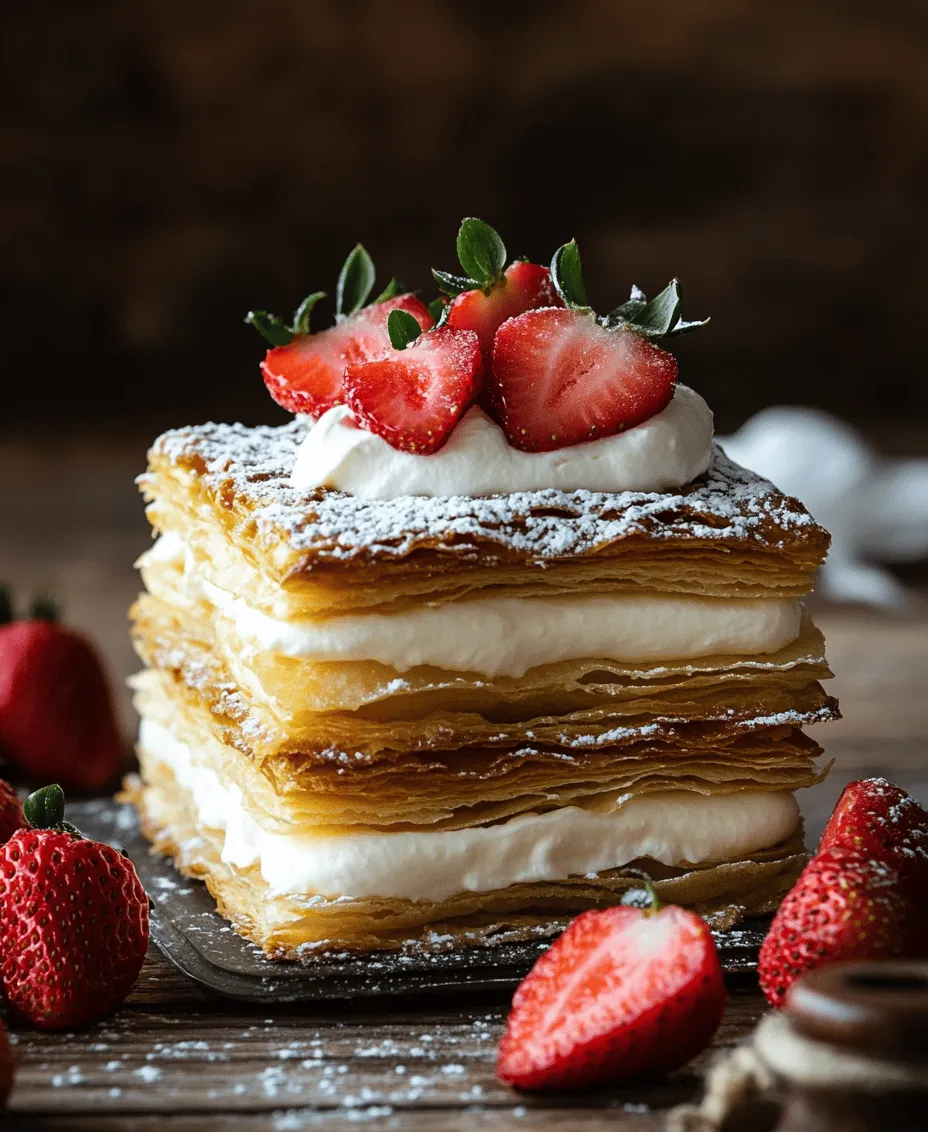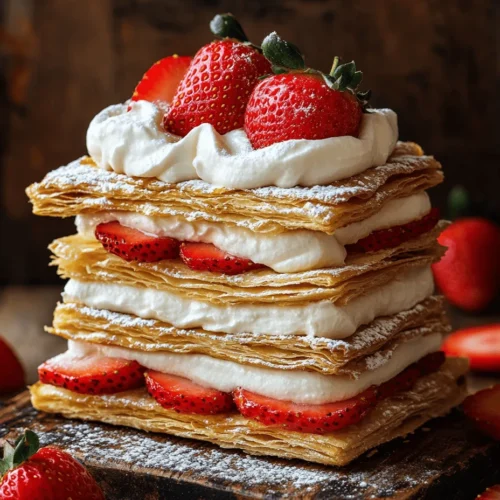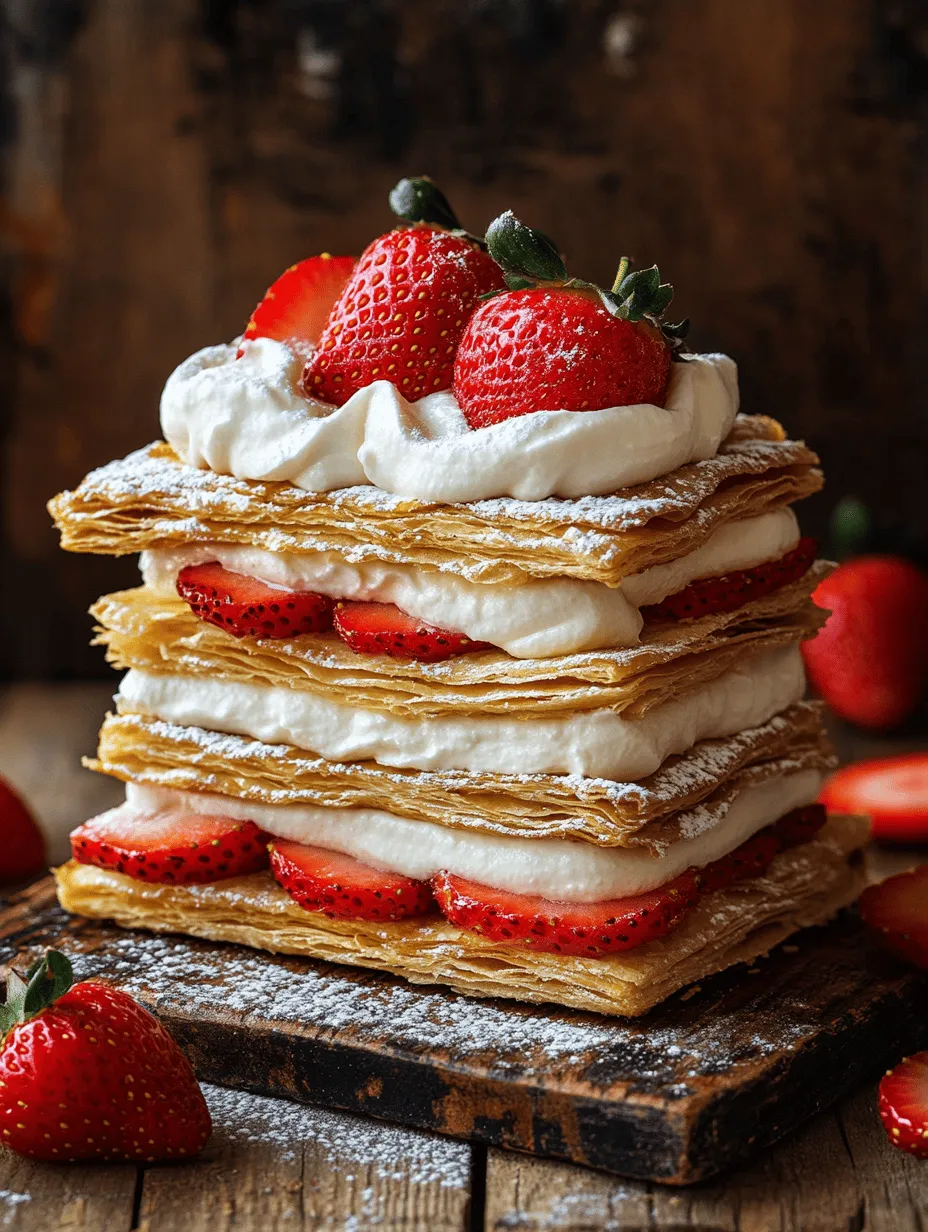Introduction
Mille-Feuille, a classic French pastry that has enchanted dessert lovers for centuries, is also affectionately known as the Napoleon. This elegant treat is renowned for its delicate layers that meld together to create a harmonious balance of flaky pastry and rich, smooth pastry cream. The allure of homemade desserts lies not only in their flavors but also in the joy of crafting them with your own hands. This Mille-Feuille recipe empowers bakers of all levels, allowing them to impress family and friends with a stunning dessert that is perfect for any occasion, from celebratory gatherings to intimate dinners.
The name “Mille-Feuille,” which translates to “a thousand leaves,” reflects the intricate layers of puff pastry that define this dessert. Each layer is a testament to the art of baking, skillfully crafted to achieve the perfect texture and flavor. As you embark on this culinary journey, you will discover that the process is as rewarding as the end result. The combination of crisp pastry, luscious cream, and the potential for creative garnishing makes Mille-Feuille a beloved choice in the realm of desserts.
Understanding Mille-Feuille
The history of Mille-Feuille is steeped in French culinary tradition, its origins tracing back to the early 19th century. While the exact birth of the pastry is often debated, it is widely believed that it was popularized by the famed French chef Marie-Antoine Carême, who was known for his elaborate pastries and intricate desserts. Mille-Feuille’s cultural significance extends beyond its rich flavors; it embodies the French philosophy of food as an art form, where every detail matters.
Traditionally, Mille-Feuille is composed of three layers of puff pastry, each separated by generous amounts of pastry cream, often flavored with vanilla. The top layer is typically finished with a glossy glaze, frequently adorned with intricate patterns or designs. The beauty of this dessert lies in its versatility—while the classic version reigns supreme, variations abound, ranging from fruit-infused creams to chocolate ganache toppings, showcasing the creativity of bakers worldwide.
Across different cultures, similar layered desserts have emerged, each with its unique twist. In Italy, for instance, the “millefoglie” is celebrated for its indulgent fillings and is often accompanied by fresh fruits. As dessert enthusiasts explore these variations, the Mille-Feuille remains a beloved symbol of French patisserie, revered for its balance of flavors and textures.
Ingredients Overview
Creating a perfect Mille-Feuille requires a thoughtful selection of ingredients, each playing a critical role in the overall success of the dessert.
Puff Pastry Sheets
The foundation of any Mille-Feuille is the puff pastry. When it comes to choosing puff pastry, bakers have two primary options: store-bought or homemade. While making puff pastry from scratch can be a labor of love, requiring patience and precision, many home bakers opt for high-quality, store-bought puff pastry for its convenience. When using store-bought, ensure that it is thawed properly and kept cold until ready to work with, as this helps achieve the desired flakiness during baking.
If you choose to make your own puff pastry, the process involves layering butter between sheets of dough and folding it multiple times to create those signature flaky layers. Regardless of your choice, the key is to handle the pastry gently to maintain its layers.
Pastry Cream
The second essential component of the Mille-Feuille is the pastry cream. This rich, velvety filling is typically flavored with vanilla, providing the perfect complement to the crisp pastry. The texture of the pastry cream is crucial; it should be smooth and thick enough to hold its shape when layered between the pastry sheets.
For those looking to experiment, variations of pastry cream can include flavors such as chocolate, coffee, or even fruit purees. Each flavor adds a unique twist, allowing bakers to personalize their Mille-Feuille to their liking.
Glaze
A classic Mille-Feuille is often topped with a glaze made from powdered sugar, which adds a touch of sweetness and visual appeal. The glaze is typically made by mixing powdered sugar with a small amount of water or milk to achieve a pourable consistency. For added flavor, bakers can incorporate vanilla extract or lemon juice into the glaze. This final touch not only enhances the dessert’s aesthetic but also brings an additional layer of taste that beautifully complements the pastry and cream.
Garnishes
While optional, garnishes can elevate your Mille-Feuille to an entirely new level. Fresh strawberries or raspberries add a burst of color and a refreshing contrast to the richness of the pastry cream. Additionally, a dollop of whipped cream can provide a light and airy texture, making each bite even more delightful. Consider using seasonal fruits to enhance the visual appeal and flavor profile, creating a dessert that is as beautiful as it is delicious.
Preparation Steps for Mille-Feuille
Creating a Mille-Feuille may appear daunting, but with clear, detailed steps, you will find the process to be both manageable and enjoyable. Follow these preparation steps to ensure success in your endeavor.
Preheating and Preparing the Puff Pastry
Before diving into the actual baking process, it is essential to preheat your oven to a temperature of 400°F (200°C). This high temperature is crucial for achieving that perfect puff and crispiness in your pastry. While the oven is heating, take the time to prepare your puff pastry.
If using store-bought puff pastry, roll it out gently on a lightly floured surface. Aim for an even thickness of about 1/8 inch. This will ensure that your pastry bakes evenly and rises beautifully in the oven. Alternatively, if you are making your own puff pastry, you should have already rolled and folded the dough to create those flaky layers.
Cutting and Baking the Pastry
Once your puff pastry is rolled out, it’s time to cut it into uniform rectangles. For a classic Mille-Feuille, you will need three rectangles for each serving. A sharp knife or pizza cutter works well for this task, ensuring clean cuts that will help with even baking.
After cutting the rectangles, it’s essential to prick the pastry with a fork before baking. This technique prevents the pastry from puffing up too much, allowing it to maintain its delicate layers while baking. Arrange the cut rectangles on a baking sheet lined with parchment paper, ensuring they are spaced apart to allow for proper expansion.
Transfer the baking sheet to the preheated oven and bake for approximately 15-20 minutes, or until the pastry is golden brown and crisp. Keep a close eye on the pastry as it bakes, as ovens can vary in temperature and baking time.
The next steps involve cooling the baked pastry and preparing the pastry cream, which will be detailed in the following sections. With each layer crafted to perfection, your homemade Mille-Feuille will soon be ready to impress.

Cooling the Pastry
Once your puff pastry is out of the oven, it’s crucial to let it cool properly before assembling your Delicate Mille-Feuille. Cooling the pastry allows it to set and firm up, making it easier to handle during assembly. If you skip this step, the layers can become soggy when you add the pastry cream, which can ruin the texture and overall presentation of your dessert.
To cool the pastry, transfer the baked sheets to a wire rack. This will allow air to circulate around the pastry, preventing steam from creating moisture on the bottom. Leave the pastry to cool completely for at least 30 minutes. It’s important to ensure the pastry is entirely cool to the touch before you proceed to the next step; otherwise, the heat can compromise the integrity of the pastry cream.
Making the Pastry Cream
Pastry cream is the heart of the Mille-Feuille, giving it that rich, velvety texture that contrasts beautifully with the flaky layers of puff pastry. Here’s a detailed method for preparing the pastry cream, along with tips to achieve the perfect consistency.
Ingredients for Pastry Cream:
– 2 cups whole milk
– 1/2 cup granulated sugar
– 1/4 cup cornstarch
– 4 large egg yolks
– 2 tablespoons unsalted butter
– 1 teaspoon pure vanilla extract
– A pinch of salt
Instructions:
1. Heat the Milk: In a medium saucepan, heat the milk over medium heat until it begins to steam, but do not let it boil. Stir occasionally to prevent the milk from scorching at the bottom.
2. Whisk the Dry Ingredients: In a separate bowl, whisk together the sugar, cornstarch, and salt. This ensures that the cornstarch is evenly distributed and prevents clumps from forming.
3. Combine Egg Yolks: In another bowl, whisk the egg yolks until they are light and pale. Gradually add the sugar and cornstarch mixture to the egg yolks, whisking continuously to combine.
4. Temper the Egg Mixture: Once the milk is heated, slowly pour about a third of it into the egg yolk mixture while whisking constantly. This will temper the eggs, preventing them from curdling.
5. Thicken the Cream: Pour the tempered egg mixture back into the saucepan with the remaining milk. Cook over medium heat, whisking constantly until the mixture thickens and comes to a gentle boil. This should take about 5-7 minutes. Once thickened, remove from heat.
6. Add Butter and Vanilla: Stir in the butter and vanilla extract until fully melted and combined. The butter adds richness and a glossy finish to the cream.
7. Cool the Pastry Cream: Transfer the pastry cream to a bowl and cover it with plastic wrap, pressing the wrap directly onto the surface of the cream to prevent a skin from forming. Let it cool at room temperature for about 30 minutes, then refrigerate until ready to use. The cream should be chilled for at least an hour to reach the perfect consistency.
Assembling the Mille-Feuille
Now that your pastry and cream are both ready, it’s time to assemble your Delicate Mille-Feuille. This step is where you can get creative and layer the pastry and cream for the most visually appealing dessert.
Instructions:
1. Prepare the Puff Pastry Sheets: Once the puff pastry is completely cool, use a sharp knife to trim the edges of each sheet to create neat edges. You should have three equal rectangular pieces for assembly.
2. Layering the Cream: Place one sheet of puff pastry on a serving platter or cake stand. Using a spatula, spread a generous layer of pastry cream over the first sheet. Smooth it out evenly using an offset spatula.
3. Add the Second Layer: Carefully place the second sheet of puff pastry on top of the cream layer. Gently press down to secure it in place. Repeat the process by adding another layer of pastry cream on top of this second sheet.
4. Finish with the Top Layer: Finally, place the third sheet of puff pastry on top. If desired, you can dust the top layer with powdered sugar for an elegant finish. Allow the assembled Mille-Feuille to chill in the refrigerator for at least 30 minutes before glazing.
Glazing and Decorating
A well-executed glaze not only enhances the visual appeal of your Mille-Feuille but also adds a layer of sweetness that complements the pastry and cream.
Ingredients for Glaze:
– 1 cup powdered sugar
– 2 tablespoons milk or water
– 1 teaspoon vanilla extract (optional)
Instructions:
1. Make the Glaze: In a small bowl, whisk together the powdered sugar, milk (or water), and vanilla extract until smooth. The glaze should be thick but pourable. Adjust the consistency by adding more milk or powdered sugar as needed.
2. Apply the Glaze: Once the Mille-Feuille has chilled, remove it from the refrigerator. Drizzle the glaze over the top layer, allowing it to cascade down the sides. You can use a spatula to gently smooth it out for an even finish.
3. Decorate: For an elegant touch, consider decorating with fresh berries, edible flowers, or a dusting of cocoa powder. You can also use melted chocolate to create decorative patterns on top.
Serving Suggestions
When it comes to serving your Delicate Mille-Feuille, presentation is key. Cut the dessert into neat squares or rectangles, allowing the layers of pastry and cream to be visible. Here are some serving suggestions:
– Portion Sizes: Aim for small to medium portions, as the Mille-Feuille is rich and satisfying. Cutting it into smaller pieces makes it easier for guests to enjoy without feeling overwhelmed.
– Plating Ideas: Serve each piece on a chilled plate for an elegant touch. Consider garnishing with a dollop of whipped cream, a sprig of mint, or a few fresh berries on the side. A drizzle of chocolate sauce can also elevate the plate’s appearance.
– Chilling Impact: Chilling the dessert before serving enhances the flavor and texture of the pastry cream. It allows the flavors to meld beautifully and ensures that the dessert holds its shape when cut.
– Pairing Options: Mille-Feuille pairs wonderfully with coffee, espresso, or a light dessert wine like Moscato. The coffee’s bitterness balances the sweetness of the pastry, while the wine complements its richness.
Common Mistakes to Avoid
Even the most experienced bakers may encounter pitfalls when making Mille-Feuille. Here are some common mistakes to watch out for:
– Overworking the Puff Pastry: It’s crucial to handle the pastry gently. Overworking can cause the layers to become tough and lose their flakiness. Always roll out the dough with minimal pressure and avoid excessive kneading.
– Incorrect Baking Time: Baking times can vary based on your oven and the thickness of the pastry. Keep an eye on your pastry and look for a deep golden color and a puffed appearance. If it’s too pale, it may need more time; if it’s too dark, it could be overbaked.
– Pastry Cream Consistency: The ideal pastry cream should be thick enough to hold its shape but still smooth and creamy. If it’s too thin, it won’t hold up between the layers. If it’s too thick, it can be difficult to spread. Pay attention to the cooking process and whisk continuously to avoid lumps.
Conclusion
Making the Delicate Mille-Feuille Magic is a rewarding experience that showcases the elegance of French pastry. From the delicate layers of puff pastry to the luxurious pastry cream, each step is essential in creating a dessert that delights both the palate and the eyes.
By following the outlined steps and avoiding common mistakes, you can successfully craft this classic dessert in your own kitchen. Embrace the process, take your time, and enjoy the satisfaction of creating something truly special. Whether for a special occasion or just a sweet treat for yourself, the Mille-Feuille is sure to impress and bring joy. Celebrate your culinary achievement and share this exquisite dessert with friends and family, allowing everyone to indulge in the magic of your homemade masterpiece.


